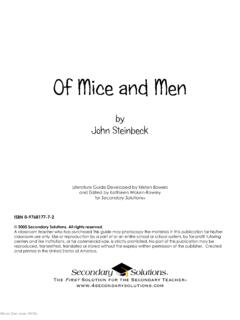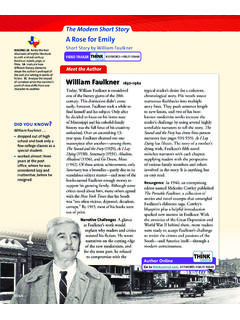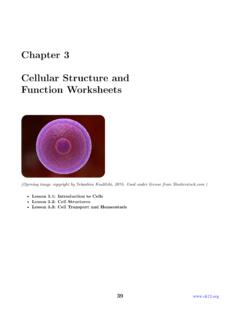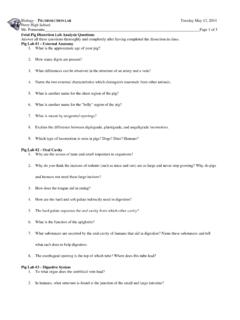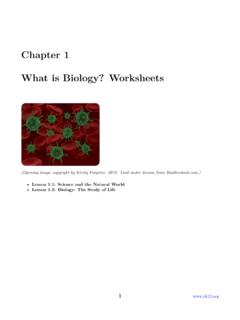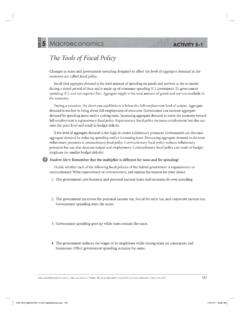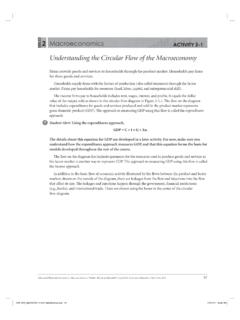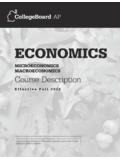Transcription of UNIT 3 Macroeconomics KEY IDEAS
1 advanced placement Economics Macroeconomics : Student Activities National Council on economic Education, New York, The Keynesian aggregate expenditure modelis a simple model of the economy and showsthe multiplied effect that changes in govern-ment spending, taxes and investment canhave on the economy. The marginal propensity to consume (MPC)is the additional consumption spendingfrom an additional dollar of income. Themarginal propensity to save (MPS) is theadditional savings from an additional dollarof income. The marginal propensity to consume andthe marginal propensity to save are relatedby MPC + MPS = 1. In the simple model,an additional dollar of income will either beconsumed or saved. The multiplier is a number that shows therelationship between changes in auton-omous spending and maximum changes inreal gross domestic product (real GDP). In a simple model, the formula for calculat-ing the multiplier isIncome expenditure11=_____=____multiplier1 MPCMPS The multiplier effects result from subse-quent rounds of induced spending thatoccur when autonomous spending changes.
2 Investment and its response to changes inthe interest rate are important in under-standing the relationship between monetarypolicy and GDP. Aggregate demand (AD) and aggregate sup-ply (AS) curves look and operate much likethe supply and demand curves used inmicroeconomics. However, these macroeco-nomic AD and AS curves depict differentconcepts, and they change for different rea-sons than do microeconomic demand andsupply curves. AD and AS curves can beused to illustrate changes in real output andthe price level of an economy. The downward sloping aggregate demandcurve is explained by the interest rate effect,the wealth effect and the net export wealth effect is also called the real-balance effect. The aggregate supply curve can be dividedinto three ranges: the horizontal range, theupward sloping or intermediate range, andthe vertical range. Shifts in aggregate demand can change thelevel of output, the price level or both.
3 Thedeterminants of aggregate demand includeconsumer spending, investment spending,government spending, net export spendingand money supply. Shifts in aggregate supply can also changethe level of output and the price level. Thedeterminants of AS include changes in inputprices, productivity, the legal institutionalenvironment and the quantity of availableresources. In the short run, economists think that equi-librium levels of GDP can occur at less than,greater than or at the full-employment level ofGDP. Economists believe that long-run equi-librium can occur only at full employment. In a dynamic aggregate demand and aggre-gate supply model of the economy, changes inwages and prices over time induce the econo-my to move to the long-run equilibrium. Fiscal policy consists of government actionsthat may increase or decrease aggregatedemand. These actions involve changes ingovernment expenditures and taxation.
4 The government uses an expansionary fiscalpolicy to try to increase aggregate demandduring a recession. The government may3 MacroeconomicsKEY IDEASUNIT108 advanced placement Economics Macroeconomics : Student Activities National Council on economic Education, New York, taxes, increase spending or do acombination of the two. The government uses a contractionary fiscalpolicy to try to decrease aggregate demandwhen the economy is overheating. The gov-ernment may increase taxes, decrease spend-ing or do a combination of the two. A change in output can also be illustrated bythe Keynesian aggregate expenditure model differs from the AD and ASmodel because in the Keynesian model theprice level is assumed to be constant. The AD and AS model can be reconciledwith the Keynesian expenditure model. Inthe horizontal range of the AS curve, bothmodels are identical. The models differ inthe intermediate and vertical ranges of theAS curve.
5 Autonomous spending is that part of ADthat is independent of the current rate ofeconomic activity. Induced spending is that part of AD thatdepends on the current level of economicactivity. Discretionary fiscal policy means the federalgovernment must take deliberate action orpass a new law changing taxes or automatic or built-in stabilizers changegovernment spending or taxes without newlaws being passed or deliberate action beingtaken. Stagflation, when the economy simultane-ously experiences inflation and unemploy-ment, can be explained by a decrease inaggregate IDEASUNITA dvanced placement Economics Macroeconomics : Student Activities National Council on economic Education, New York, EquilibriumThis activity is designed to give you practice with manipulations of the aggregate expenditure shows you how the expenditure schedule is derived and how it helps to determine the equilibriumlevel of income.
6 This activity assumes that the price level is constant with the consumer price indexor price level having a value of 100. All numbers in Figure are in billions of constant ScheduleTotal SpendingIncomeConsumptionInvestment Government(Aggregate(Output)SpendingSpen dingSpendingExpenditure)$2,400$2,500$300 $1002,6002,6003001002,8002,7003001003,00 02,8003001003,2002,9003001003,4003,00030 01003,6003,1003001003,8003,2003001001. Use the data on consumption spending and income to draw the consumption function on thegraph in Figure the function Using the consumption function you have just drawn and the data on investment and governmentspending, draw the aggregate expenditure schedule on the same graph. Label it AE (C + I + G).What is the difference between the aggregate expenditure schedule and the consumptionfunction?3. Now draw a line representing all the points at which total spending and income could be this the 45 The 45 line represents all the points that could be the equilibrium level of total spending.
7 Nowcircle the one point that isthe equilibrium level of total spending. What is the equilibrium level oftotal spending on your graph? _____MacroeconomicsLESSON 1 ACTIVITY 19 UNITA dapted from William J. Baumol and Alan S. Blinder,Economics, Principles and Policy,3rd ed. (New York: Harcourt Brace &Company, 1985), p. 55. James Chasey, Homewood-Flossmoor High School, Flossmoor, Ill., contributed to this placement Economics Macroeconomics : Student Activities National Council on economic Education, New York, Based on the data in Figure ,and assuming that the full-employment level of total spending is$3,600 billion, what conclusions can you draw about the equilibrium level of total spending?6. Based on the data in Figure , and assuming that the full-employment level of total spending is$3,200 billion, what conclusions can you draw about the equilibrium level of total spending?7. If government spending increased by $100 billion, what would be the new equilibrium level oftotal spending?
8 _____ For the increase of $100 billion in government spending,total spending increased by _____. Explain why this 1 ACTIVITY 19 (continued)UNIT$2,00002,0002,2002,4002,6 002,8003,0003,2003,4003,600$3,800 AGGREGATE EXPENDITURES(billions of constant dollars)2,2002,4002,6002,8003,0003,200 REAL NATIONAL INCOME(output in billions of constant dollars)Figure Expenditure Model3,4003,6003,800 advanced placement Economics Macroeconomics : Student Activities National Council on economic Education, New York, with APC, APS, MPC and MPSPart AAverage PropensitiesTheaverage propensity to consume(APC) is the ratio of consumption expenditures (C) to disposableincome (DI), or APC = C / propensity to save(APS) is the ratio of savings (S) to disposable income, or APS = S / Using the data in Figure , calculate the APC and APS at each level of disposable income first calculation is completed as an Propensities to Consume and to SaveDisposableIncomeConsumptionSavingAPC APS$0$2,000 $2,000 2,0003,600 1, ,0005,200 1,2006,0006,800 8008,0008,400 40010,00010,000012,00011,6004002.
9 How can savings be negative? BMarginal PropensitiesThemarginal propensity to consume(MPC) is the change in consumption divided by the change in dis-posable income. It is a fraction of any change in DI that is spent on consumer goods: MPC = C / propensity to save(MPS) is the fraction saved of any change in disposable MPS is equal to the change in saving divided by the change in DI: MPS = S / Using the data in Figure , calculate the MPC and MPS at each level of disposable income. Thefirst calculation is completed as an example. (This is not a typical consumption function. Its pur-pose is to provide practice in calculating MPC and MPS.)MacroeconomicsLESSON 1 ACTIVITY 20 UNITA ctivity written by John Morton, National Council on economic Education, New York, , and James Spellicy, Lowell High School,San Francisco, placement Economics Macroeconomics : Student Activities National Council on economic Education, New York, Propensities to Consume and to SaveDisposableIncomeConsumptionSavingMPC MPS$12,000$12,100 $100 13,00013, ,00013,80020015,00014,50050016,00015,100 90017,00015,6001,4004.
10 Why must the sum of MPC and MPS always equal 1?Part CFigure in APC and MPC as DI IncreasesDisposableIncomeConsumptionSavi ngsAPCAPSMPCMPS$10,000$12,000 $2,000 20,00021,000 1,00030,00030,000040,00039,0001,00050,00 048,0002,00060,00057,0003,00070,00066,00 05. Complete Figure , and answer the questions based on the completed What is the APC at a DI level of $10,000? _____ At $20,000? _____7. What happens to the APC as DI rises? _____8. What is the MPC as DI goes from $50,000 to $60,000? _____ From $60,000 to $70,000? _____9. What happens to MPC as income rises? _____ What happens to MPSas income rises? _____10. What is the conceptual difference between APC and MPC?MacroeconomicsLESSON 1 ACTIVITY 20 (continued)UNITA dvanced placement Economics Macroeconomics : Student Activities National Council on economic Education, New York, Magic of the MultiplierThe people in Econoland live on an isolated island.
